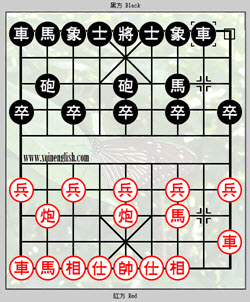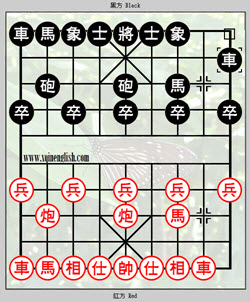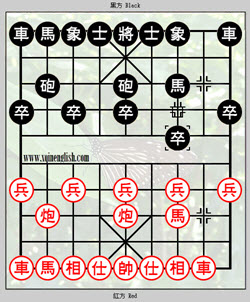Introduction of the Same Direction Cannons in Xiangqi
Both the Same Direction Cannons and the Opposite Direction Cannons are the two oldest Xiangqi openings. Two games were played using the opening systems in Shi Lin Guang Ji, which is the earliest record of Xiangqi that is still extant. It would mean that the Same Direction Cannons has been around for about a thousand years.
While the Same Direction Cannons has waned in popularity, slowly giving way to the Screen Horse Defense and other counters, it remains a frequently seen opening system in tournaments around the world. It is quite a feat in itself because it has been about a thousand years since Shi Lin Guang Ji was published.
Indeed, the Same Direction Cannons was the major topic of discussion in the Secret in the Tangerine, the Plum Flower Manuals, and other ancient manuals that came later. Although the Screen Horse Defense would later dethrone the Same Direction Cannons as the Queen of all counters against Red’s Central Cannon, the Same Directions would still be seen in tournaments even up till today.
Content for this article
- Brief History of the Same Direction Cannons
- Defining the Same Direction Cannons
- Characteristics of the Same Direction Cannons
- Must-know Variations
- A Peek into Modern Day Variations
- Important Literature
Brief History of the Same Direction Cannons
The history of the evolution of the Same Direction Cannons can be divided into three stages: (1)
- The first stage would be the Ming Dynasty (1368-1644AD) and Qing Dynasty (1644-1911AD). This stage is known as the ancient stage of development.
- The second stage of development would be the period from 1911-1949AD. This stage could be considered to be the pre-modern stage.
- The third stage would be from 1949AD until now, which Grandmaster Wang Jialiang called the modern-day stage.
During the Qing and Ming Dynasties
Since the ancient times, the Central Cannon has been the most played opening for Red. It is still the case today as the Central Cannon would roughly account for about half of all the games played in tournaments everywhere.
The Central Cannon would be an ideal opening for Red because Red would start attacking the central file on the very first move. It was thus natural for Black to ‘copy’ Red’s first move and counter with a Central Cannon too for Black’s first move.
However, which cannon to move would result in drastically different situations. If the cannon on the same flank as Red’s cannon was moved, that is the ipsilateral cannon was used to counter, and the Same Direction Cannons would be the resulting opening system.
Several ancient manuals studied the Same Direction Cannons in-depth during the Ming and Qing Dynasties:
- Invincible after Training in the Caves
- 18 Stances of the Golden Roc
- Secret in the Tangerine ***Highly Recommended
- Plum Flower Manual by Wang
- Plum Flower Springs Manual etc
The Same Direction Cannons shown in these ancient manuals, most notably the Secret in the Tangerine, demonstrated brilliant kills and exciting tactics to get the win. The Webmaster fell in love with some of the variations in the ancient manuals years ago and still try to go over them now and then. Xiangqi Opening Theory was still in its rudimentary stages, and there were many dubious moves. Still, Xiangqi lovers can identify with the joy obtained from reading the. The Webmaster thinks that the ancient manuals are THE BEST PLACE for the beginner to start learning the Same Direction Cannons, if not for opening theory in general. If the visitor were able to identify the dubious moves, it would mean that he had already had some fundamental knowledge of the basic opening systems in modern-day.
Pre-modern stage
Civil wars, natural disasters, et cetera plagued China during this period, where the Same Direction Cannons stalled in its revolution. Nevertheless, basic Opening Theory took form, and the Same Direction Cannons was one of the beneficiaries.
Modern-day Stage
1956 is one of the most important years in the calendar of Xiangqi. The first-ever Chinese National Individual Xiangqi Championships started. For the first time in China, there was a ‘unified’ champion. The first-ever winner of the coveted event was Grandmaster Yang Guanlin, who repeated the feat for a total of four times. (Note: He held the cup together with Hu Ronghua in 1962, which was the first and last time that tiebreaks could not produce a champion.)
Yang Guanlin was widely regarded as the BEST Same Direction Cannons player in the 1950s. However, the King of the Same Direction Cannons lost BOTH his Same Direction Cannons games to Hangzhou’s Liu Yici (刘亿慈), and Heilongjiang’s Zhang Donglu (张东录) sparked an uproar. The birth of the ‘Heavenly Horse Variation’ (天马行空) proved that attacking with a file chariot by pushing it R2+6 was questionable. The Heavenly Horse Variation also gave hope to players playing the Same Direction Cannons as Black. This defeat marked another turning point in the revolution of the Same Direction Cannons. (1 页 6)
One of Yang Guanlin’s arch-nemeses, GM Wang Jialiang, was also an expert on the opening system, and he is credited with many new variations. GM Wang Jialiang was also a prolific author, and amongst his many works was the Same Direction Cannons Treatise.
Grandmaster Hu Ronghua, who is the most decorated Xiangqi player of all time, was also an expert with the Same Direction Cannons. Perhaps GM Hu’s greatest contribution was the Deferred Chariot Variation.
There were many more Same Direction Cannons experts since the 1950s, which invented new variations and novelties.
Another noteworthy event to mention was the Baoren Cup, which was held in the 1990s. It was a theme tournament whereby competitors could only play the Same Direction Cannons for both colors. Unfortunately, there have not been any similar theme tournaments of that nature to the Webmaster’s knowledge.
Defining the Same Direction Cannons
For newcomers to Xiangqi, the following diagrams will explain the Same Direction Cannons and their major variations.
|
|
Same Direction Cannons Ranked vs. Filed Chariot |
|
|
|
Characteristics of the Same Direction Cannons
Generally speaking, most of the variations of the Same Direction Cannons are very volatile. You KNOW that you would be in a for a tooth-for-tooth fight when Black counters with the Same Direction Cannons.
However, modern-day Same Direction Cannons seem to have slowed the pace a reasonable bit. While there are still many instances of out-of-nowhere kills, improvements in modern-day opening theory have seen more emphasis on defense of the central file. Developing both horses as proper horses is now recommended for both colors.
Key considerations:
- Development or deferred development of Red’s Right Chariot and Black’s Left Chariot (when they are developed)
- Development of Red’s Left Horse and Black’s Right Horse
- Development of the 3rd and 7th Pawns for both colors (Double Headed Snake Pawns?, Edge Pawn?)
- Development of the Red’s Left Cannon and Black’s Right Cannon (58 Cannons, 57 Cannons, 56 Cannons or 59 Cannons)
- Development of the remaining chariot Red’s Left Chariot and Black’s Right Chariot
- Movement of the Advisor in relation to the enemy Chariot
- Movement of the Elephant in relation to the enemy Chariot
Must-know Boards
There are simply too many variations and classical matches to know about the Same Direction Cannons. However, the Webmaster feels that the following is a list that must be known.
The first board would explain why it would NOT be wise to capture the enemy's central Pawn.
The next board would be the first board in the Secret in the Tangerine. The Webmaster has added comments from his translation of the ancient classic which is for sale on Amazon. Only the major variation is given. For interested readers, please visit the publications section for more.
The third board would probably be one of the oldest boards, also from the Secret in the Tangerine, that demonstrates the Same Direction Cannons: Filed Chariot vs. Ranked Chariot.
The next board would be the infamous Heavenly Horse Variation (天马行空). This variation caused a National Champion to be dethroned.
The original score of the game is given below. There is a slight but harmless discrepancy in the order of the moves.
A Peek into Modern Day Variations
The Webmaster has racked his brains for over a month how he would present the major variations for the Same Direction Cannons. After much deliberation, he gave up and decided to present the commonly played tabiat that was found in books.
The following table is the table of contents that the Webmaster has translated from the Same Direction Cannons Treatise. The book was a compilation of three other treatises: (1)
- Same Direction Cannons: Filed Chariot vs. Ranked Chariot
- Same Direction Cannons: Ranked Chariot vs. Filed Chariot
- Same Direction Cannons: Deferred Chariot (for both colors)
Same Direction Cannons: Filed Chariot vs. Ranked Chariot
|
Chapter |
English Translation |
Notes |
|
1. |
Introduction |
Includes ancient manuals, modern-day strategies. General Introduction. |
|
2. |
正马三兵对右肋车 Red:Left Proper Horse with 3rd Pawn Advancement Black: Rib Chariot (R9=4) |
11 Boards. Discussion on Black attacking with the Cross-riverbank Chariot, Pawn Ranked Chariot, and 3rd Pawn Advancement. Red would continue with R4+4/R4+5/P3+1/ H2+3/H2+1 |
|
3. |
正马对3卒 Red: Left Proper Horse Black: 3rd Pawn Advancement |
6 Boards Red would continue with R2+4/R2+5/P3+1 |
|
4. |
正马三兵对肋车边马 Red: Left Proper Horse and 3rd Pawn Advancement Black: Rib Chariot (R9=4) with Right Edge Horse |
19 Boards Red would usually have initiative. Red would continue with one of the following: H3+4/A6+5/R2+6/C8+4/ C8=9/R2+5/C5=4/P7+1 |
|
5. |
两头蛇对双横车 Red: Double Headed Snake Pawns Black: Double Pawn Ranked Chariots |
23 Boards. A very important variation that is still commonly seen. Red would continue with: R2+5/H3+4/C8+2/C8=9/ A4+5/A6+5/E7+9 |
|
6. |
黑马后藏车 Black: Hides the Chariot behind the Horse (Double Pawn Ranked Chariots) |
7 Boards. Continuation of Chapter 5, but Black would play R1=3 for this infamous variation! Stem game 1982 Yang Guanlin vs. Hu Ronghua! Several variations would occur for Red before Black would continue with R1=3. |
|
7. |
两头蛇对正马边炮 Red: Double Headed Snake Pawns Black: Right Proper Horse with Edge Cannon |
2 Boards. Not as good as Black’s Double Pawn Ranked Chariots. |
|
8. |
正马左士对右肋车 Red: Left Proper Horse with Left Advisor Black: Ranked Chariot which has crossed the palace |
4 Boards A6+5 would try to trick Black to attack the Left Flank. Black would continue with: H2+3/H2+1/P7+1. |
|
9. |
红巡河车 Red: Red would choose to develop his right chariot as a riverbank chariot (R2+4). |
11 Boards. Provide the staunchest defense for Red. Black would have a hard time countering. |
|
10. |
红士角炮 Red chooses Palcorner Cannon for (56 Cannons) |
12 Boards Defense oriented Opening |
|
11. |
正马七兵对正马 Red: Left Proper Horse with 7th Pawn Advancement Black: Early Right Proper Horse (before Black’s R9=4) |
7 Boards Black would continue with: |
|
12. |
正马七兵对右肋车 Red: Left Proper Horse and 7th Pawn Advancement Black: Right Rib Chariot (R9=4) |
10 Boards P7+1 gained popularity later than P3+1 (Chapter 2,3,4, etc.). Black would continue with: H2+1/P7+1/R4+5/H2+3 |
|
13. |
Others |
6 Boards |
Same Direction Cannons: Ranked Chariot vs. Filed Chariot
|
Chapter |
English Translation |
Notes |
|
1. |
炮打中卒(兵) Central Cannon capturing Enemy Central Pawn |
5 Boards. Shows interesting comments about actually capturing the enemy central pawn. Discussed both colors capturing the enemy’s central pawn. |
|
2. |
单边封 Single Flank Blockade |
6 Boards Discussed Black developing his left chariot as a Pawn Ranked Chariot, Riverbank Chariot. |
|
3. |
红双横车 Red would choose to attack with Double Ranked Chariots. |
3 Boards Red would continue with R2+4/R2+5/P3+1。 Very aggressive variation where Red would sacrifice his right horse for attack. |
|
4. |
巡河炮对过河车 Red: Left Riverbank Cannon Variation Black: Left Pawn Ranked Chariot |
3 Boards. Old variation studied in the ancient manuals. Black would choose to advance his chariot R8+6 or R8+5. |
|
5. |
肋车捉炮 Red: Rib Chariot threatens Black cannon (R6+6) |
4 Boards Black would continue with R8+6 or R8+5. |
|
6. |
正马伸左炮 Red: Left Proper Horse and C8+5 |
4 Boards |
|
7. |
诱卒跃马对敛炮冲卒 Red: Left Proper Horse and enticing Black to charge pawn before developing horse Black: Thundering Cannon and charging 3rd pawn |
3 Boards |
|
8. |
黑巡河车 (一) Black Filed Riverbank Chariot Part 1 Red would advance R6+7. |
6 Boards. Beginning of 4 chapters on this major variation. |
|
9. |
黑巡河车 (二) Black Filed Riverbank Chariot Part 2 Red would play H8+7 |
16 Boards |
|
10. |
黑巡河车 (三) Black Filed Riverbank Chariot Part 3 |
25 Boards |
|
11. |
黑巡河车 (四) Black Filed Riverbank Chariot Part 4 |
26 Boards |
|
12. |
黑先进右马 Black would develop his right horse as a proper horse. |
7 Boards Wait and see approach. |
|
13. |
Others |
17 Boards |
Same Direction Cannons: Deferred Chariot
Three sections that were listed in this section:
- Same Direction Cannons: Field Chariot vs. Deferred Chariot
- Same Direction Cannons: Ranked Chariot vs. Deferred Chariot
- Same Direction Cannons: Red Deferred Chariot
These three systems were discussed in the same order given above in the book as Sections 1-3, respectively.
|
Section/Chapter |
English Translation |
Notes |
|
1/1. |
Section 1: Same Direction Cannons: Filed Chariot vs. Deferred Chariot 黑进7卒 Black P7+1 |
76 Boards Bulk of book. Five ways for Red to continue attacking: a) H8+7, b) P7+1, c) H8+9, d) R2+4 and e) R2+6 |
|
1/2 |
Section 1: Same Direction Cannons: Filed Chariot vs. Deferred Chariot 黑进正马 Black H2+3 |
20 Boards Ancient variation |
|
1/3 |
Section 1: Same Direction Cannons: Filed Chariot vs. Deferred Chariot 黑进边马 Black H2+1 |
11 Boards |
|
2/1 |
Section 2: Same Direction Cannons: Ranked Chariot vs. Deferred Chariot 红车过宫 Red R1=6 (4th move) |
6 Boards |
|
2/2 |
Section 2: Same Direction Cannons: Ranked Chariot vs. Deferred Chariot 红车早过宫 Red R1=6 (3rd move) |
3 Boards |
|
2/3 |
Section 2: Same Direction Cannons: Ranked Chariot vs. Deferred Chariot 红车晚过宫或不过宫 Red delays or does not play R1=6 |
1 Board |
|
3/1 |
Section 3: Red Deferred Chariot Chapter 7: 红三兵对直车 Red 3rd Pawn Advancement vs. Filed Chariot |
18 Boards |
|
3/2 |
Section 3: Red Deferred Chariot Chapter 8: 红三兵对横车 Red 3rd Pawn Advancement vs. Ranked Chariot |
8 Boards |
|
3/3 |
Section 3: Red Deferred Chariot Chapter 9: 红三兵直车对横车边马 Red 3rd Pawn Advancement vs. Filed Chariot |
15 Boards |
Important Literature
For a topic as big as the Same Direction Cannons, there have been many books and treatises dedicated to it. In the Webmaster’s humble opinion, the following books are the best books/treatises on the Same Direction Cannons.
《顺炮全集》 Same Direction Cannons Treatise by GM Wang Jialiang 王嘉良 (1)
They don’t write them like they used to.
Grandmaster Wang Jialiang, Grandmaster Hu Ronghua, Grandmaster Yang Guanlin, et cetera were some of the most important Xiangqi grandmasters to have revolutionized the Same Direction Cannons. They all contributed important variations that changed the way the Same Direction Cannons as played.
《布局定式与战理.》 (2) .Master Yan Wenqing and Grandmaster Zhang Qiang’s trilogy on Xiangqi openings has been THE standard for Xiangqi openings the past decade. While the material on the Same Direction Cannons was limited, there were several good boards and discussions on the Same Direction Cannons. The trilogy was republished in 2018 and in the Webmaster’s humble opinion, it interested readers who want to collect books, this trilogy rates highly on the list of collector’s items.
References
1. 王, 嘉良 and 李, 德林. 象棋现代布局丛书 顺炮全集. 成都 : 蜀蓉棋艺出版社, 1998. 7-80548-566-6/G.567.
2. 阎, 文清 and 张, 强. 新概念象棋布局教程 布局疑形与攻击. 北京 : 北京体育大学出版社, 1999. 7-81051-387-7.
3. Png, Jim Hau Cheng. Lexicon of Xiangqi (Chinese Chess) Terms in English. Taipei : Jim Png Hau Cheng, 2017. 978-957-43-4707-0.
4. Huang 黄Shaolong 少龙. 象棋布局新解丛书--斗炮烽火. 北京 : 北京体育出版社, 2003年1月. 7-81051-671-X.
5. 傅, 宝胜. 棋迷过招系列 -- 象棋实战技法. 合肥 : 安徽科学技术出版社, 2009. 978-7-5337-3373-5.
6. 刘, 殿中. 象棋新编课程 象棋布局精要. 北京 : 北京体育大学出版社, 2000. 7-81051-486-5/G.416.
7. 屠, 景明 and 杨, 柏伟. 象棋词典. 上海 : 上海文华出版社, 2009. 978-7-80740-339-5/G。475.
8. 朱, 宝位. 棋牌入门丛书 象棋入门. 合肥 : s.n., 1994. 978-7-5337-0734-7.
9. 刘, 剑青 and 刘, 健. 《桔中秘》详解. 成都 : 蜀蓉棋艺出版社, 2001. 7-80548-717-0.
10. 阎, 文清 and 张, 强. 新概念象棋布局教程 布局骗着与对策. 北京 : 北京体育大学出版社, 1999. 7-81051-386-9/G.342.
11. —. 新概念象棋布局教程 布局定式与战理. 北京 : 北京体育大学出版社, 1999. 7-81051-388-5/G.344.




